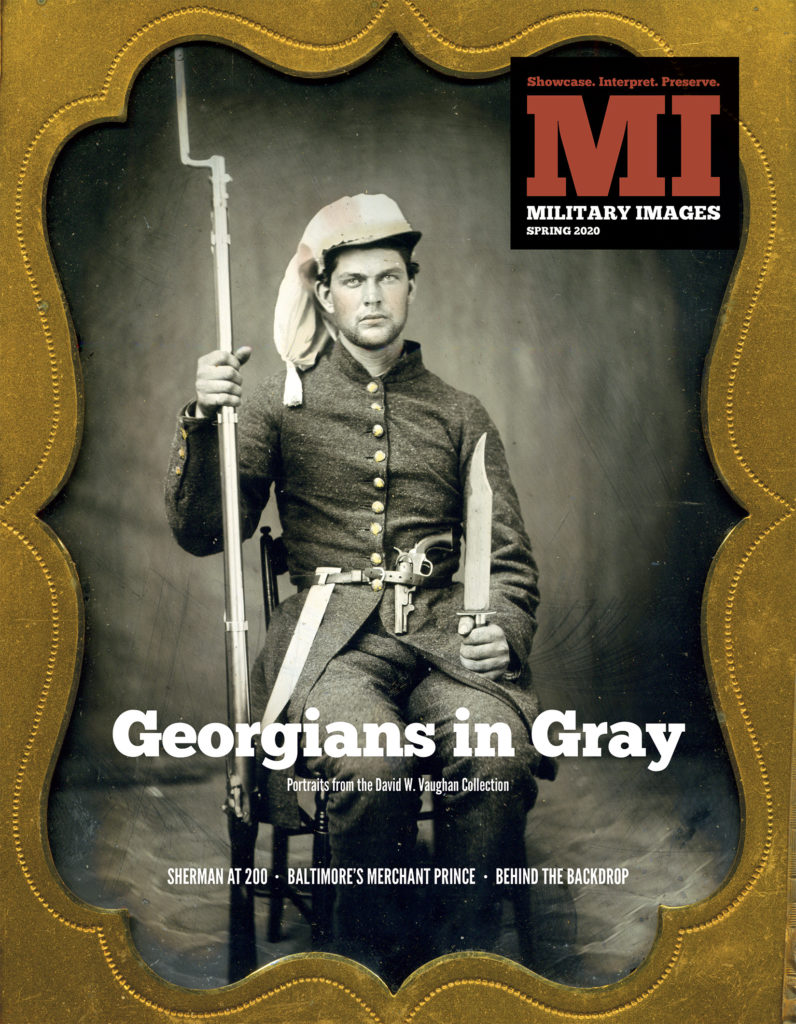The complete issue

Vol. XXXVIII, No. 2
(80 pages)
Print edition: Visit our store to check availability
Digital edition: Visit JSTOR.org to purchase
Subscribe to MI
Explore the MI Archives:
Browse | Advanced search | Tutorial
Inside
Cover image
A half-plate ambrotype from the David W. Vaughan Collection pictures William Houston House of the 13th Georgia Cavalry.
Table of Contents (p. 1)
Editor’s Desk (p. 2)
The editor introduces two new departments, Behind the Backdrop by Adam Ochs Fleischer and Material Culture, which is guest hosted. The editor also notes a modification in policy regarding colorized images, which will be allowed for educational purposes. Such images reproduced in the magazine will be accompanied by the un-colorized image.
Mail Call (pp. 3-4)
Feedback includes comments on Fakes, Forgeries and Frauds,and a note regarding a misidentified epaulette.
Military Anthropologist (p. 4)
A tree map diagram visualizes enlistments in the Union and Confederate armies.
Passing in Review (pp. 6-8)
Featured media includes The 16th Michigan Infantry in the Civil War (Michigan State University Press) by Kim Crawford, 100 Significant Civil War Photographs: Atlanta Campaign (Historical Publications LLC), and the movie short Hold My Horse (Look Around You Ventures, LLC) starring Christian Stolte and Patrick Webb.
Photo Sleuth by Kurt Luther (pp. 8-13)
In “Lost and Found in the Library of Congress,” Luther details his journey that began with a questionable caption on a single glass plate negative and ended with an extensive examination of captions attached to 16 negatives—11 of which he found proved incorrect or unclear.
Antebellum Warriors (p. 14)
A sixth-plate ambrotype discovered in Florence, S.C., pictures a militiaman. He may have been a member of the Darlington Rifles, a local militia company.
The Honored Few (p. 16)
Willie Johnston, an 11-year-old drummer in the 3rd Vermont Infantry, managed to hold on to his instrument during the desperate march from the Malvern Hill battlefield to Harrison’s Landing. On July 4, 1862, after Maj. Gen. George B. McClellan ordered a review to boost morale, only Johnston had a drum to play. Other musicians had either discarded their drums during the march or put them in temporary storage aboard baggage wagons. Word of Willie’s lone performance made its way to Washington, D.C., and resulted in his receipt of the nation’s highest military honor.
Most Hallowed Ground (p. 18)
Navy Rear Adm. Richard Worsam Meade was an irascible man, a trait he shared in common with his famous uncle, Maj. Gen. George Gordon Meade. Rear Adm. Meade’s temper got the best of him late in his career when he insulted President and Commander-in-Chief Grover Cleveland. The incident ended with Meade’s dismissal from the Navy. He is buried at Arlington National Cemetery.
The Citizenry by Alison Renner (p. 20)
Four-year-old Major Willie Bagley, “The Wisconsin Infant Drummer,” enjoyed a brief stint in the spotlight as a performer for P.T. Barnum. The legendary Barnum posted with Bagley to mark the association.
Fakes, Forgeries and Frauds by Perry M. Frohne (pp. 22-23)
In “The Weaponization of Technology and Psychology,” Frohne details how today’s forgers “are far smarter, have far better technology, and are very close to producing perfect fake cartes de visite.” He illustrates the column with two cartes that fooled him.
Georgians in Gray: Images from the David W. Vaughan Collection, with text by August Marchetti (pp. 24-35)
More than 15 years ago, a gallery of David W. Vaughan’s portraits of Georgia Confederates debuted in this magazine. Since then, the collection has been recognized across the country, including the landmark 2013 exhibit Photography and the American Civil War at the Metropolitan Museum of Art in New York City. Vaughan has continued to add to his collection. This gallery highlights recent acquisitions.
Commemorating Uncle Billy’s 200th Birthday in Portraits, with images from the Jerry Everts Collection (pp. 36-45)
William Tecumseh Sherman is front center in 25 portraits that document his rise from major general in 1863 to General of the Army to his retirement.
Chivalrous Legacy: The story behind Tunis A.M. Craven’s last recorded words at Mobile Bay by Ronald S. Coddington (pp. 46-48)
The Battle of Mobile Bay is known for two distinct human moments connected to torpedoes: Rear Adm. David Farragut’s utterance paraphrased as “Damn the torpedoes, full speed ahead,” and Cmdr. Tunis Augustus Macdonough Craven’s words as his ironclad Tecumseh sank, “After you, sir.” This story puts Craven’s words in context, and is illustrated with four portraits of him.
Antebellum Midshipmen: A survey of Navy portraits with images from the Dr. William Schultz Collection (pp. 50-54)
Fourth in a series of galleries of pre-Civil War daguerreotypes from the Schultz collection, this survey examines nine portraits. They include an early view of a midshipman by pioneer photographer John Plumbe, John “Jack” Wilkes, Jr., the son of career naval officer Charles Wilkes, and John Gardner Mitchell, for whom Mitchell Bay in Alaska is named.
A Merchant Prince Goes to War: Baltimore’s Lt. Noah Dixon Walker, C.S.A. by Ronald S. Coddington with Ross J. Kelbaugh (pp. 56-60)
Noah Dixon Walker received an offer of $200,000 ($6 million in today’s dollars) not to enlist in the Confederate army. The man who made the offer was his father, wealthy Baltimore merchant Noah Walker. His son passed on the offer to become an officer in the 44th Virginia Infantry. This is his story.
Accidental American, Soldier, Artist, Photographer: The notable journey of Civil War veteran William Kurtz by Scott Valentine (pp. 62-65)
After fate dashed his dream to start a new life in China, Germany’s William Kurtz found himself stranded on the shores of the U.S. with little money and prospects. He managed to find a job in a New York City photographer’s studio, and it launched him on a prosperous high-profile career.
Inside “The Empty Sleeve” by James S. Brust (pp. 66-67)
Maj. Gen. Oliver O. Howard is perhaps best remembered for his post-Civil War roles with the Freedman’s Bureau and the establishment of Howard University in Washington, D.C. Far less known is a speech he gave in Maine soon after the amputation of his arm after it was severely damaged during the 1862 Battle of Fair Oaks, Va. Howard’s words inspired poet David Barker’s “The Empty Sleeve,” which holds a unique place in American popular culture.
Seamless Sharpshooters: How a revolutionary breakthrough in garment design proved undesirable in war by Brian T. White (pp. 68-70)
Seamless overcoats proved the rage in the late 1850s, thanks to innovative efforts to manipulate wool into form-fitting clothing. Among those who took advantage of the latest technology was Col. Hiram Berdan, the engineer, inventor and crack marksman who raised two regiments of sharpshooters for the Union army. His men received seamless overcoats as part of their standard issue uniform.
Behind the Backdrop: Origins, artistry and photographers by Adam Ochs Fleischer (pp. 72-75)
In his inaugural column, “A Daguerreian Pioneer at the Rendezvous of Distribution,” Fleischer examines the distinctive painted canvas depicting a scene that includes Sibley tents and a palm tree. His investigations highlight the man behind the backdrop, John Jones, and the gallery he operated.
Material Culture by Frederick C. Gaede (pp. 76-77)
In this inaugural column, guest author Gaede investigates leather neck stocks from 1851-1865. Though they are long gone from the military, they live on in the Marine moniker “Leatherneck.”
Stragglers: Distinctive Images from MI contributors (p. 79)
Included are three portraits of Union soldiers, including a Zouave who served in the 9th New York Infantry from the Anthony F. Gero Collection.
The Last Shot (p. 80)
A sixth-plate tintype from the Paul Russinoff Collection pictures a man reading a newspaper. He is dressed in shirtsleeves and what appears to be a military vest.




































